Foot Orthotics
Orthotics:
Orthotics refers to both field of study and external devices used to support or correct musculoskeletal deformities and /or abnormalities. These also helps to improve the function of movable parts of the body. Orthotics combines biomechanics, anatomy and material science to provide therapeutic support and improve patient quality of life through external devices. These include Braces, splints and supports for the back, knee, arm, wrist, foot …etc.
Foot orthotics, also called orthoses or shoe inserts, are devices worn inside shoes to provide support and improve foot function. These modifications can be customized in footwears as well to give preventive and therapeutic benefits. Foot orthotics aim to support the foot, redistribute pressure, and improve biomechanics. They can help correct structural problems like high arches or flat feet. Orthotics can reduce pain, improve foot alignment, and help prevent or delay the need for surgery.
Before diving deep into the modifications it’s good to know the parts of a shoe, The basic anatomy of a shoe.
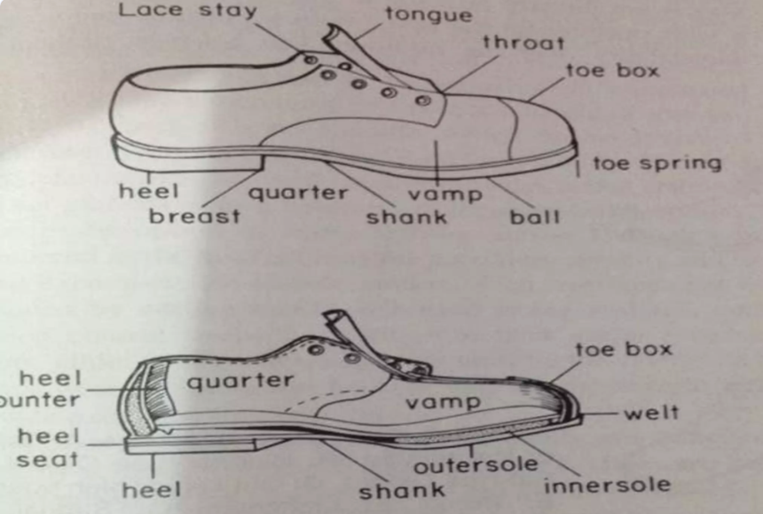
Though all the components are important of particular interest for us will be Please get familiarised with the terms as we will discuss more about it and what is best for what conditions.
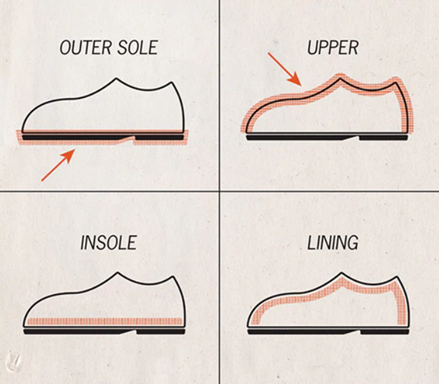
Orthotics are also made up of variety of materials like Polyurethane, EVA – (MCR – Micro Cellular Rubber & MCP – Micro Cellular Polymer), Silicon, Plastic, Plastazote (Foam)… Every individual need is different and so is the orthotic material need. When considering the material to be used the factors to be taken into account include
- Patient Weight: Heavier the patient the denser or harder the material to be. Hardness of the material (Esp the ones used in footwears) is measured with an instrument called durometer and Its unit is called Shore A Hardness. The values are in the range of 0 to 100 with 0 being very Soft to 100 being hard. For footwear insoles, studies have shown a Shore value of 15 to 25 is ideal. This hardness helps to dissipate pressure, relieve pain and suits diabetic patients. MCP made of this shore value is called Medical Grade MCP. At Rx Surgicals only medical grade MCP are used. When the shore value is lower than this the material becomes very soft, which only causes a compression at the point of contact and pressure dissipation is limited. When the shore value is higher than 25 the material becomes harder and that too does not help to relieve the pain as it exerts a counter pressure on your foot.
- Biomechanical need: If the purpose is correction more rigid materials are needed. Esp for correction of Arch and Plantar fasciitis. But if the patient needs more comfort because of pain softer materials or semi rigid materials that accommodate pressure is to be used. Softer materials like Eva, Silicon and Plastazote are used for patients with Diabetes, Callus and Corns.
Generally, for footwears modifications the materials are selected as per the individuals need. However, the most commonly used material for customization is MCP and MCR.
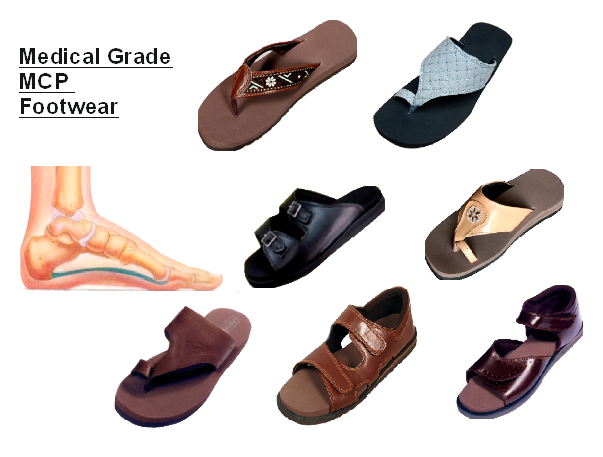
What’s the difference between MCP and MCR
Microcellular Rubber (MCR) and Microcellular Polymer (MCP) are both materials used to manufacture footwears. They have micropores which allows pressure dissipation.
- MCR is made from natural or synthetic rubber. MCP is made from a variety of materials, including polyurethane or EVA (ethylene-vinyl acetate).
- MCR is denser than MCP, and so heavier than MCP. MCP is more flexible than MCR, and make it more comfortable
- MCR produces heat over long standing, MCP produces significantly less heat.
- MCR being rubber tends to become more brittle.
All through we have mostly talked about the insole. Let’s touch upon the other components as well
Since these footwear modifications are needed for elderly patients as well the grip on outer sole is an important criterion to be looked into. The treads on the outer sole have to well designed for firm grip and traction. Also, if the patient is having diabetic neuropathy the outer sole has to be rigid and preferably a Rocker bottom. I will explain more on it when coming to Diabetic footwears.
If the patient has a forefoot issue its always better to avoid slip-ons and footwear with a toe stick. This is because when the person walks the footwear tends to come off and to hold the footwear in place, the person holds on firmly to the toe stick for grip which in turn exerts increased pressure in the forefoot region leading to callus, corns, Bunion …In this case, If you notice the footwear tends to have pressure impressions on the 1st metatarsal head and the digits.
Since this footwear modification are also to be done for diabetic patient’s utmost care to be given for the inner lining of the footwear. It has to be soft and preferably seamless. Materials like poly cotton or MCP lining helps as a suitable inner liner.
Now we know in general what to look for in foot orthotics, let’s go into specifics Which conditions require specific orthotics and what kind of orthotics
You require orthotics for any of the following foot and ankle conditions:
Flat Feet
As discussed earlier its important to address the flat feet issues with Medial Arch Footwear. This helps to restore the balance and prevent pronation. If the deformity is very prominent you may require additionally a medial wedge along with arch to compensate the pronation.
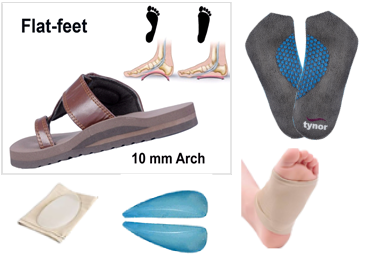
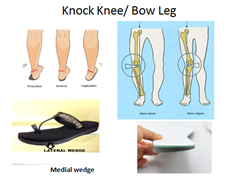
Pronation /Supination
Generally, person with high Arch the foot tends to shift laterally and in order to balance it a lateral wedge correction will be helpful. Also, if you note when the arch is collapsed and the foot pronated it also leads to knock knee leading to increased friction of the knee joint laterally.
This may lead to development of Osteo Arthritis. The other way round with high arch and foot supinated it leads to bow leg pattern and the friction in the knee is more medial. The wedge height is determined with the angle of pronation or supination. In some case you may also note the hind foot is Supinated while the forefoot is pronated. With proper plantar analysis its important to have the wedges accordingly compensating the hind foot and fore foot pressure. Heel can also be supported with a cup shaped elevation (Gobra Heel) for better comfort and fit.
Calcaneal Spur
In cases of Calcaneal Spur/Calcaneal Bursitis apart from Heel Cushion its important to biomechanically shift the pressure from the heel to the mid foot. This can be achieved by adding a 15mm heel to the footwear or using Heel cushion for the shoes.
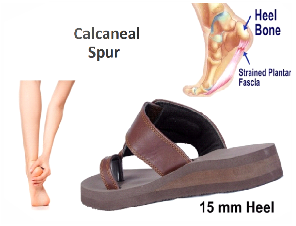
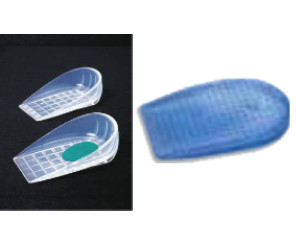
Remember its always better to have a flat outer sole and the heel tapered to it rather than having separate Heel. Also make sure the heel height is not too high as it exerts pressure on the forefoot leading other issues. Having a heel is contra indicated for patients with varicose veins.
Plantar Fasciitis
In cases of plantar Fasciitis an Arch with Heel relieves pain and provides comfort. Medial Arch insoles with Heel cups also are effective foot orthotics to be worn with footwear. Material to be used depends on the need but generally a semi rigid material is suitable to provide optimal support to the plantar aspect.
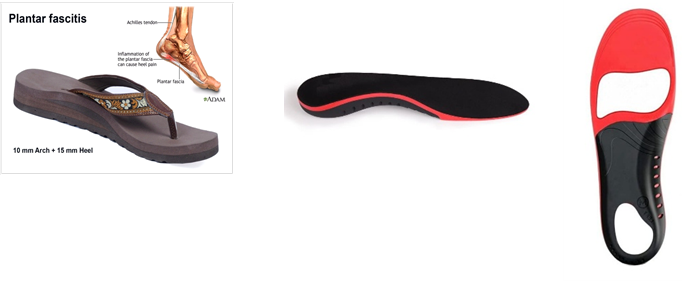
Metatarsalgia
In case of forefoot pain or callus, the pain can be reduced by offloading the metatarsal region. In the initial stages a simple metatarsal bar or pad will help to relieve the pressure in the forefoot. This can be incorporated in the footwear or can be done as insoles for the shoe. Its preferable to have footwear without toe sticks to reduce the forefoot pressure.
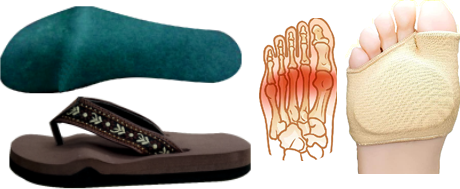
Hammer Toe
Straightening the digits helps to offload pressure due to Claw, Hammer or mallet toe. Toe crest made of silicon helps to achieve this objective.
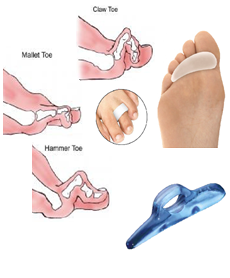
Bunion (Hallux Valgus)
Toe separators incorporated in the footwear or separately made of silicone helps to prevent further deterioration. Silicon toe separators also come with Bunion shield this help especially while wearing shoes, preventing chaffing. Bunion splints are apt as night splints. These exert 3 way force – pulls the toe outwards, pushes the bunion inwards and also the splint incorporates transverse arch which gives further support at the metatarsal region.
In certain cases, foot alignment socks also help as toe separator for all five fingers.
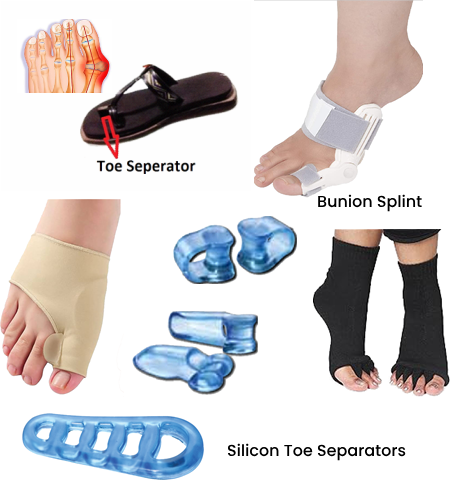
Corns and Calluses
Off loading corns and calluses involves multiple approaches depending on the region and aggressiveness.
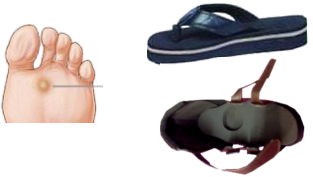
Depending on region, If the corn or callus is in the forefoot as said earlier footwear with toe sticks is to be avoided. The foot has to rest completely in the footwear. For a shoe it has to have wides and higher toe box so that the foot does not rub with any material.
If the corn or callus is mild addition of 5 mm latex or silicon layer will help to distribute the pressure. If the corn is painful, offloading that region is important. Scooping can be done for small corns provided the surrounding tissue is healthy and viable. For corn in the digits a metatarsal bar will be helpful to reduce the pressure in the forefoot. Please note heel footwear to be avoided for persons with corn in the forefoot region. If the corn is on the lateral or medial aspect a suitable wedge can be added after analysing the walking pattern. A small corn in the heel can be addressed by adding a 15mm heel to the footwear, where in the pressure gets bio mechanically shifted.
Stiff Big Toe (Hallux Rigidus)
In cases of Hallux rigidus metatarsal bars or silicone toe caps are helpful. These reduce the loading in the toe and thereby reduces discomfort.
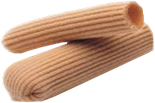

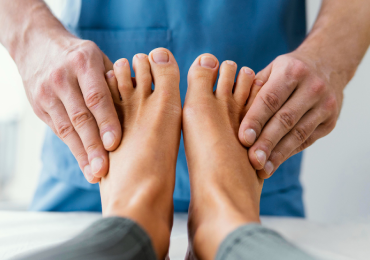
146 thoughts on “Foot Orthotics”
Wade4163
July 26, 2025https://shorturl.fm/umMJj
Christian2635
July 26, 2025https://shorturl.fm/Z9MRx
Ellis1388
July 28, 2025https://shorturl.fm/LbsZr
Autumn3354
July 29, 2025https://shorturl.fm/r0WKG
Amira2924
July 29, 2025https://shorturl.fm/2fjI0
Allen1171
July 30, 2025https://shorturl.fm/YTKSy
Alivia641
August 1, 2025https://shorturl.fm/zGBJd
Alma1331
August 1, 2025https://shorturl.fm/kqZ89
Damon1255
August 1, 2025https://shorturl.fm/cxAJd
Cassandra1508
August 2, 2025https://shorturl.fm/RByeg
Jermaine853
August 2, 2025https://shorturl.fm/u53dk
Gabriel3549
August 3, 2025https://shorturl.fm/wVn3M
Alondra1547
August 3, 2025https://shorturl.fm/fwLqa
Brinley4227
August 4, 2025https://shorturl.fm/uWeav
Haleigh1850
August 4, 2025https://shorturl.fm/rUFWm
Jesus1409
August 4, 2025https://shorturl.fm/S6nH3
Geoffrey4557
August 4, 2025https://shorturl.fm/UvYq0
Adele1910
August 4, 2025https://shorturl.fm/UALmw
Eliza2044
August 4, 2025https://shorturl.fm/PDniU
William569
August 4, 2025https://shorturl.fm/JEYbN
Diane3778
August 4, 2025https://shorturl.fm/UuRZt
Edgar1683
August 4, 2025https://shorturl.fm/tbx9w
Moses4376
August 5, 2025https://shorturl.fm/HhLL1
Alastair1096
August 5, 2025https://shorturl.fm/pRy09
Hannah1360
August 6, 2025https://shorturl.fm/eshoy
Alexander407
August 6, 2025https://shorturl.fm/vnmoD
Mason856
August 6, 2025https://shorturl.fm/swYa1
Campbell1098
August 7, 2025https://shorturl.fm/GtUlU
Nevaeh3195
August 7, 2025https://shorturl.fm/W45m3
Makenzie4790
August 7, 2025https://shorturl.fm/LS5sk
Rosa4952
August 7, 2025https://shorturl.fm/GLiRe
Curtis4905
August 8, 2025https://shorturl.fm/GiuWK
Rosemary772
August 8, 2025https://shorturl.fm/lpXyl
Cole3099
August 10, 2025https://shorturl.fm/yh2H2
Ainsley884
August 10, 2025https://shorturl.fm/7cCLW
Ada2339
August 10, 2025https://shorturl.fm/WtCz4
Nelson3006
August 10, 2025https://shorturl.fm/QAmgL
Harvey3801
August 10, 2025https://shorturl.fm/FCjgp
Brayden2030
August 10, 2025https://shorturl.fm/lgdqJ
Sally1843
August 10, 2025https://shorturl.fm/9ooWk
Jared2087
August 10, 2025https://shorturl.fm/Dlfv7
Jaden1087
August 11, 2025https://shorturl.fm/hIUQL
Jonah3481
August 12, 2025https://shorturl.fm/86pz6
Bernice1757
August 12, 2025https://shorturl.fm/6M1FY
Neil3147
August 12, 2025https://shorturl.fm/J7H9G
Victoria286
August 12, 2025https://shorturl.fm/OCemS
Kathy4542
August 13, 2025https://shorturl.fm/waNb8
Drew4355
August 13, 2025https://shorturl.fm/7y2oH
Lindsey4419
August 13, 2025https://shorturl.fm/OCuF1
Alastair1208
August 13, 2025https://shorturl.fm/2FfAz
Ken3290
August 14, 2025https://shorturl.fm/4t5GG
Pedro589
August 14, 2025https://shorturl.fm/u1O5q
Jared2641
August 14, 2025https://shorturl.fm/NFgcS
Kirk1532
August 14, 2025https://shorturl.fm/RySKw
Channing2261
August 14, 2025https://shorturl.fm/FtV0v
Alejandra1640
August 15, 2025https://shorturl.fm/GHmni
Adriana312
August 15, 2025https://shorturl.fm/563W3
Martha2670
August 16, 2025https://shorturl.fm/30uej
Frances3764
August 16, 2025https://shorturl.fm/QW0sR
Jaxon862
August 16, 2025https://shorturl.fm/g7D8S
Armando2219
August 17, 2025https://shorturl.fm/wKhby
Lilly3790
August 17, 2025https://shorturl.fm/03V2U
Jill379
August 17, 2025https://shorturl.fm/S28Zi
Bennett4237
August 17, 2025https://shorturl.fm/sOKyr
Rodney4149
August 18, 2025https://shorturl.fm/2hVNU
Renee2193
August 18, 2025https://shorturl.fm/aycfn
Francesco1953
August 18, 2025https://shorturl.fm/phFbr
Eden1620
August 18, 2025https://shorturl.fm/T1gLq
Elena648
August 18, 2025https://shorturl.fm/cqw42
Karen4869
August 19, 2025https://shorturl.fm/Khp2P
Alexis2840
August 19, 2025https://shorturl.fm/HBmsy
Samantha2717
August 19, 2025https://shorturl.fm/yDqid
Clyde2631
August 20, 2025https://shorturl.fm/23cYb
Clinton2492
August 20, 2025https://shorturl.fm/CGEum
Diego4963
August 20, 2025https://shorturl.fm/EAfaN
Elmer1226
August 20, 2025https://shorturl.fm/5zknK
Landon4392
August 20, 2025https://shorturl.fm/V6F4y
Jayden4492
August 20, 2025https://shorturl.fm/RSO0m
Gabrielle2502
August 21, 2025https://shorturl.fm/6kPfU
Lucy826
August 21, 2025https://shorturl.fm/jtcnG
Lila670
August 21, 2025https://shorturl.fm/l6XUz
Angelina3958
August 22, 2025https://shorturl.fm/ouWOZ
Lynne987
August 22, 2025https://shorturl.fm/rjEIA
Paula554
August 22, 2025https://shorturl.fm/nZte4
Gareth4308
August 22, 2025https://shorturl.fm/rStR6
Aliyah3469
August 23, 2025https://shorturl.fm/b0Cgj
Crystal4659
August 24, 2025https://shorturl.fm/jqugw
Frances4676
August 24, 2025https://shorturl.fm/V6JOx
Pamela3646
August 24, 2025https://shorturl.fm/gkhSZ
Bill2109
August 24, 2025https://shorturl.fm/mn2cb
Harvey799
August 24, 2025https://shorturl.fm/oqPWE
Hendrix4482
August 24, 2025https://shorturl.fm/gXJ7O
Greg4808
August 24, 2025https://shorturl.fm/j430W
Declan139
August 25, 2025https://shorturl.fm/zkfD1
Toby8
August 25, 2025https://shorturl.fm/KB2si
Diane1689
August 25, 2025https://shorturl.fm/AI3s6
Alonso2625
August 25, 2025https://shorturl.fm/NJY8v
Makenzie4640
August 26, 2025https://shorturl.fm/EMjKw
Isaac2076
August 26, 2025https://shorturl.fm/KqHWj
Trent750
August 26, 2025https://shorturl.fm/IItiE
Alfred2036
August 26, 2025https://shorturl.fm/Ny5n4
Marco120
August 26, 2025https://shorturl.fm/4NctQ
Kingston494
August 27, 2025https://shorturl.fm/zqiH4
Bentley1050
August 27, 2025https://shorturl.fm/GHj0R
Kiley1015
August 28, 2025https://shorturl.fm/cnIgJ
Haven4312
August 28, 2025https://shorturl.fm/3xqoN
Xavier18
August 28, 2025https://shorturl.fm/3Fer6
Mia811
August 31, 2025https://shorturl.fm/1LXbr
Aubree3514
September 3, 2025https://shorturl.fm/g1O5B
Makenzie2575
September 3, 2025https://shorturl.fm/tHlYo
Susan1280
September 3, 2025https://shorturl.fm/bVbg1
Ginger3466
September 3, 2025https://shorturl.fm/bM1Il
Jimmy2089
September 3, 2025https://shorturl.fm/kTxXu
Judith1445
September 3, 2025https://shorturl.fm/0NnXR
Channing3582
September 3, 2025https://shorturl.fm/0NnXR
Kristina2462
September 4, 2025https://shorturl.fm/hpGun
Frederick1734
September 4, 2025https://shorturl.fm/gv53b
Angelo2915
September 5, 2025https://shorturl.fm/u10ja
Anabel1390
September 10, 2025https://shorturl.fm/MYHa6
Darius2569
September 16, 2025https://shorturl.fm/TXYKg
Garrett2766
September 22, 2025https://shorturl.fm/aS2Nv
Janice843
September 23, 2025https://shorturl.fm/fadIY
Jayden971
October 1, 2025https://shorturl.fm/dgcIQ
Ariel3387
October 1, 2025https://shorturl.fm/Z8FFW
Kara2354
October 3, 2025https://shorturl.fm/xK5hp
Maliyah4824
October 3, 2025https://shorturl.fm/5Gk2x
Virginia3214
October 4, 2025https://shorturl.fm/pMqWR
Adria2122
October 5, 2025https://shorturl.fm/rUtU0
Aaron1666
October 7, 2025https://shorturl.fm/aanNX
Marcel406
October 9, 2025https://shorturl.fm/jKd0W
Rachel4670
October 10, 2025https://shorturl.fm/msRJf
Emory3710
October 15, 2025https://shorturl.fm/Z6qif
Anika2300
October 16, 2025https://shorturl.fm/zTac9
Marilyn3708
October 16, 2025https://shorturl.fm/O6ZYz
Sofia2971
October 17, 2025https://shorturl.fm/5smtF
Theo390
October 21, 2025https://shorturl.fm/TdkeE
Reed1464
November 7, 2025https://shorturl.fm/plx8d
Tiffany3873
November 8, 2025https://shorturl.fm/kfVl2
Charles1829
November 10, 2025https://shorturl.fm/xNU30
Emilie1182
November 11, 2025https://shorturl.fm/PdcQf
Braxton1087
November 11, 2025https://shorturl.fm/3p8XD
Caroline2604
November 11, 2025https://shorturl.fm/Lcs1E
Kristin4473
November 15, 2025https://shorturl.fm/b1nHt
Greyson4869
November 15, 2025https://shorturl.fm/ghB3s
Sandra1057
November 18, 2025https://shorturl.fm/poVSv
Katelyn2911
November 19, 2025https://shorturl.fm/JzwBZ